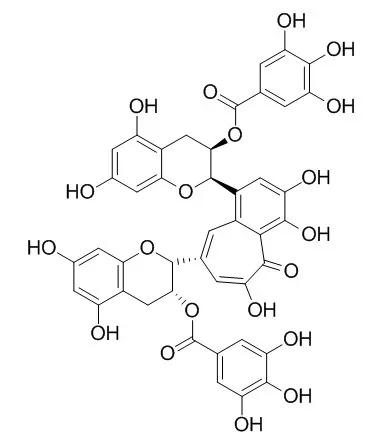| In vitro: |
| J Agric Food Chem. 2009 Jul 8;57(13):5816-22. | | Increase of theaflavin gallates and thearubigins by acceleration of catechin oxidation in a new fermented tea product obtained by the tea-rolling processing of loquat ( Eriobotrya japonica ) and green tea leaves.[Pubmed: 19507893] | In a project to produce a new fermented tea product from non-used tea leaves harvested in the summer, we found that kneading tea leaves ( Camellia sinensis ) with fresh loquat leaves ( Eriobotrya japonica ) accelerated the enzymatic oxidation of tea catechins.
METHODS AND RESULTS:
The fermented tea obtained by tea-rolling processing of tea and loquat leaves had a strong, distinctive flavor and a plain aftertaste, which differed from usual black, green, and oolong teas. The phenolic constituents were similar to those of black tea. However, the concentrations of theaflavin 3-O-gallate, Theaflavin 3,3'-di-O-gallate, and thearubigins were higher in the tea leaves kneaded with loquat leaves than in tea leaves kneaded without loquat leaves.
CONCLUSIONS:
The results from in vitro experiments suggested that acceleration of catechin oxidation was caused by the strong oxidation activity of loquat leaf enzymes and a coupled oxidation mechanism with caffeoyl quinic acids, which are the major phenolic constituents of loquat leaves. | | Biosci Biotechnol Biochem. 2003 Feb;67(2):396-401. | | Evaluation of the anti-oxidative effect (in vitro) of tea polyphenols.[Pubmed: 12729007] | Forty-three polyphenols from tea leaves were evaluated for their anti-oxidative effect against lipid peroxidation by the ferric thiocyanate method in vitro.
METHODS AND RESULTS:
Among these, 1,4,6-tri-O-galloyl-beta-D-glucose (hydrolyzable tannin) showed the highest anti-oxidative activity against lipid peroxidation, even stronger than that of 3-tert.-butyl-4-hydroxyanisole (BHA). The assay demonstrates that tea polyphenols, except for desgalloylated dimeric proanthocyanidins that possess a catechin structure in the upper unit and desgalloylated flavan-3-ols, and excepting Theaflavin 3,3'-di-O-gallate, had more anti-oxidative activity than that of alpha-tocopherol.
CONCLUSIONS:
The chemical structure-activity relationship shows that the anti-oxidative action advanced with the condensation of two molecules of flavan-3-ols as well as with 3-O-acylation in the flavan skeleton such as that by galloyl, (3'-O-methyl)-galloyl, and p-coumaroyl groups. | | Eur J Pharmacol. 1999 Feb 19;367(2-3):379-88. | | Theaflavin-3,3'-digallate from black tea blocks the nitric oxide synthase by down-regulating the activation of NF-kappaB in macrophages.[Pubmed: 10079014] |
METHODS AND RESULTS:
Electrophoretic mobility shift assay (EMSA) indicated that theaflavin-3,3'-digallate(Theaflavin 3,3'-di-O-gallate) blocked the activation of nuclear factor kappaB (NF-kappaB), a transcription factor necessary for inducible NO synthase induction. Theaflavin-3,3'-digallate(Theaflavin 3,3'-di-O-gallate) also blocked phosphorylation of IkappaB from cytosolic fraction and reduced lipopolysacchride-induced nuclear accumulation of transcription factor NF-kappaB p65 and p50 subunits.
CONCLUSIONS:
These results suggest that theaflavin-3,3'-digallate(Theaflavin 3,3'-di-O-gallate) decreases the protein levels of inducible NO synthase by reducing the expression of inducible NO synthase mRNA, and the reduction could be via preventing the activation of NF-kappaB, thereby inhibiting the induction of inducible NO synthase transcription. It was also demonstrated that the gallic acid moiety of theaflavin-3,3'-digallate(Theaflavin 3,3'-di-O-gallate) is essential for their potent anti-inflammation activity. | | Front Pharmacol . 2020 Oct 21;11:514313. | | Identification of Theaflavin-3,3'-Digallate as a Novel Zika Virus Protease Inhibitor[Pubmed: 33192499] | | Abstract
Mounting evidence indicates that Zika virus (ZIKV) is closely related to neurological disorders such as microcephaly and Guillain-Barré syndrome. There are currently no effective vaccines and FDA-approved inhibitors against ZIKV infection. The flaviviral heterodimeric serine protease NS2B-NS3 plays an essential role in ZIKV maturation and replication, thus becoming a promising target in anti-ZIKV therapy. Herein, we developed a fluorescence-based screening assay to search for inhibitors targeting the ZIKV NS2B-NS3 protease (ZIKVpro), and identified theaflavin-3,3'-digallate (ZP10), a natural active compound derived from black tea, as a potent ZIKV protease inhibitor in vitro (IC50 = 2.3 μM). ZP10 exhibited dose-dependent inhibitory effect on ZIKV replication (EC50 = 7.65 μM). Western blot analysis suggested that ZP10 inhibited the cleavage processing of viral polyprotein precursor in cells either infected with ZIKV or expressing minimal self-cleaving proteinase NS2B-3 protease, resulting in inhibition of virus growth. Moreover, ZP10 was showed to directly bind to ZIKVpro, and a docking model further revealed that ZP10 interacted with several critical residues at the proteolytic cavity of the ZIKVpro. This study highlights that ZP10 has anti-ZIKV potency through ZIKVpro inhibition, which indicates its potential application in anti-ZIKV therapy.
Keywords: Zika virus; anti-virus; natural active compound; protease; screen. |
|






 Cell. 2018 Jan 11;172(1-2):249-261.e12. doi: 10.1016/j.cell.2017.12.019.IF=36.216(2019)
Cell. 2018 Jan 11;172(1-2):249-261.e12. doi: 10.1016/j.cell.2017.12.019.IF=36.216(2019) Cell Metab. 2020 Mar 3;31(3):534-548.e5. doi: 10.1016/j.cmet.2020.01.002.IF=22.415(2019)
Cell Metab. 2020 Mar 3;31(3):534-548.e5. doi: 10.1016/j.cmet.2020.01.002.IF=22.415(2019) Mol Cell. 2017 Nov 16;68(4):673-685.e6. doi: 10.1016/j.molcel.2017.10.022.IF=14.548(2019)
Mol Cell. 2017 Nov 16;68(4):673-685.e6. doi: 10.1016/j.molcel.2017.10.022.IF=14.548(2019)